|
The Year in Review
Overview of the Group’s Business Performance
During the reporting term, the second year of the Bank’s current medium-term management plan (the first such plan for the new, post-merger Kiyo Bank), we concentrated our efforts on harnessing the improved efficiency and reduced costs realized from the merger of Kiyo Bank and Wakayama Bank and on reorganizing our marketing structure for greater effectiveness. As a result of these efforts, both deposits and loans surpassed our target figures, realizing a dramatic increase in Kiyo Bank’s business scale. Moreover, despite poor sales of investment trusts due to a worsened investment environment, sales of personal pension plans did well, and Kiyo Bank enjoyed increased earnings from fees and commissions relating to assets under custody. Total expenses also recorded a decline thanks to greater efficiency resulting from the merger of Kiyo and Wakayama banks during the previous term.
The economy of Wakayama Prefecture has been generally healthy, and although signs of a slowdown were seen in certain parts of the region during the reporting term, credit costs, including expenses for bad debt disposal, were at the same level as in the previous year.
On a consolidated basis, the Kiyo Financial Group’s total income amounted to ¥92.7 billion, total expenses ¥79.7 billion, income before income taxes and minority interests ¥13.0 billion and net income ¥13.3 billion.
On a nonconsolidated basis, Kiyo Holdings recorded operating income (primarily dividends received from the subsidiary bank) of ¥28.6 billion, operating profit of ¥24.1 billion, ordinary profit of ¥23.7 billion, and net income of ¥23.2 billion.
In November 2007, Kiyo Holdings purchased all of its own shares held by its subsidiary Kiyo Bank. The shares were included in treasury and cancelled. This normalized the intra-Group capital relationship.
Deposits and Assets under Custody
We are continuing to follow our policy of expanding our marketing staff to enable an adequate response to diversifying customer needs. We are also opening dedicated personal banking branches. These efforts have been rewarded with a steady growth in the value of deposits and assets under custody.
Deposits
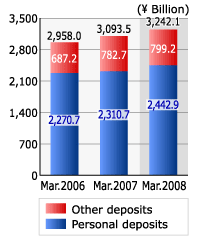 The balance of deposits as of March 31, 2008 was ¥3,242.1 billion, representing an increase of ¥148.6 billion over the previous term. Of this, personal deposits accounted for ¥2,442.9 billion, up ¥132.2 billion year-on-year. The balance of deposits as of March 31, 2008 was ¥3,242.1 billion, representing an increase of ¥148.6 billion over the previous term. Of this, personal deposits accounted for ¥2,442.9 billion, up ¥132.2 billion year-on-year.
Assets under Custody
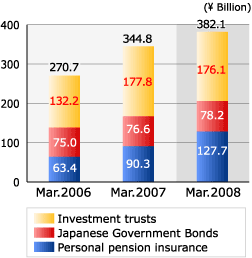 Thanks to aggressive marketing of investment trusts and personal pension insurance plans to meet our individual customers’ asset management needs, the balance of assets under custody grew to ¥382.1 billion at term-end. Thanks to aggressive marketing of investment trusts and personal pension insurance plans to meet our individual customers’ asset management needs, the balance of assets under custody grew to ¥382.1 billion at term-end.
Loans
To increase loans to small and medium-sized companies, we improved our relationship banking services during the reporting period by increasing the frequency of marketing staff visits to corporate customers and by strengthening marketing activities to potential customers. We also opened new branches dedicated to corporate banking services. We also took active steps to address the funding needs of individuals, primarily in regards to mortgage loans.
Term-End Loan Balance
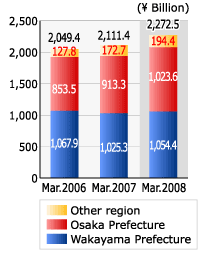 The balance of total loans at March 31, 2008 was ¥2,272.5 billion, up ¥161.0 billion over the previous term, thanks to growth in both Wakayama and Osaka prefectures. The balance of total loans at March 31, 2008 was ¥2,272.5 billion, up ¥161.0 billion over the previous term, thanks to growth in both Wakayama and Osaka prefectures.
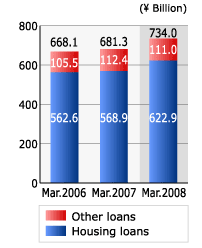 Personal Loans
Personal Loans
The term-end balance of all personal loans rose by ¥52.6 billion over the previous term, while the balance of housing loans rose by ¥53.9 billion.
Capital Ratio
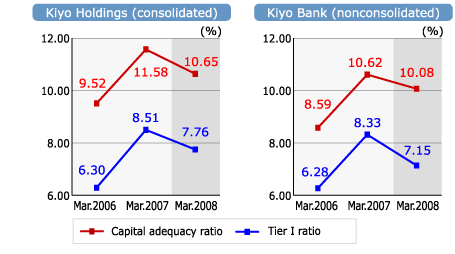 The regulatory capital of Kiyo Holdings at March 31, 2008 stood at ¥178.4 billion on a consolidated basis, for a year-on-year decline of ¥1.2 billion. This was largely the result of a fall in unrealized gains on available-for-sale securities. Due to our efforts to increase loans, risk-weighted assets rose by ¥122.9 billion over the previous term-end. As a result, the capital ratio of Kiyo Holdings (in line with the standards for the holding companies of regional banks operating in Japan only) edged downward by 0.93 percentage points to 10.65% at the end of the reporting period. The regulatory capital of Kiyo Holdings at March 31, 2008 stood at ¥178.4 billion on a consolidated basis, for a year-on-year decline of ¥1.2 billion. This was largely the result of a fall in unrealized gains on available-for-sale securities. Due to our efforts to increase loans, risk-weighted assets rose by ¥122.9 billion over the previous term-end. As a result, the capital ratio of Kiyo Holdings (in line with the standards for the holding companies of regional banks operating in Japan only) edged downward by 0.93 percentage points to 10.65% at the end of the reporting period.
The capital ratio of Kiyo Bank, on a nonconsolidated basis (in line with the standards for regional banks operating only in Japan) stood at 10.08%, also down 0.54 percentage points from the previous term.
Nonperforming Loans (Loans Disclosed under the Financial Reconstruction Law)
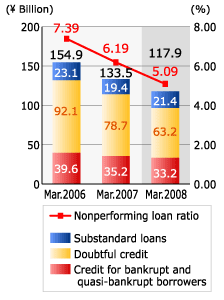 With the aim of bringing the nonperforming loan ratio down to less than 5% by the year ending March 2009, the final year of our first medium-term business plan, the Bank worked to accelerate the disposal of nonperforming loans so as to bring the ratio down to the normal level. This included improving customers’ debtor categories through involvement in support for business reconstruction and management improvement. With the aim of bringing the nonperforming loan ratio down to less than 5% by the year ending March 2009, the final year of our first medium-term business plan, the Bank worked to accelerate the disposal of nonperforming loans so as to bring the ratio down to the normal level. This included improving customers’ debtor categories through involvement in support for business reconstruction and management improvement.
As a result of these efforts, the balance of nonperforming loans decreased by ¥15.5 billion from the end of the previous year to ¥117.9 billion, and the nonperforming loan ratio also dropped 1.10 percentage points to 5.09%.
Coverage of Nonperforming Loans
Out of total nonperforming loans of ¥117.9 billion, the percentage covered by means such as collateral and allowances for possible loan losses was 91.3%.
| |
Amount of
borrowers |
Amount of
preservation |
|
Coverage ratio |
| Mortgage/Guarantee |
Allowance |
| Credit for bankrupt and quasi-bankrupt borrowers |
33.2 |
33.2 |
31.2 |
2.0 |
100.0% |
| Doubtful credit |
63.2 |
60.5 |
43.9 |
16.5 |
95.7% |
| Substandard loans |
21.4 |
13.9 |
6.6 |
7.3 |
65.1% |
| Total |
117.9 |
107.8 |
81.8 |
25.9 |
91.3% |
|

